The U.S. health system is traveling down a fiscally dangerous road. By 2020, over one-fifth of the nation’s economic resources—21.3 percent of the gross domestic product (GDP)—will go toward providing health care without commensurate return in access, health outcomes, or value. In spite of all that spending, an estimated 61 million people will be uninsured in 2020, and more than 30 million more will be underinsured—at risk of incurring medical bills they cannot afford and accumulating debt for health care expenses.
In February 2009, The Commonwealth Fund Commission on a High Performance Health System proposed an integrated plan for putting the U.S. health system on the path to high performance, which would lead to better access, improved quality of care, and greater efficiency by 2020. Major features of this proposal include creation of a national insurance exchange that offers an affordable choice of private and public health insurance plans to all Americans; requirements that individuals obtain coverage and that employers help finance coverage for workers; promotion of more patient-centered, efficient, and integrated health care delivery through the use of innovative provider payment approaches; promulgation of health information technology and comparative-effectiveness research to improve quality and enhance value; and adoption of public health initiatives to reduce obesity and tobacco use and improve overall health and quality of life.
National debate is currently centered on the question of how to slow the growth of health care costs to sustain coverage while ensuring quality of care. A controversial component of this debate is whether to offer a new public plan choice to the under-65 population. This report by Commonwealth Fund staff is intended to inform this debate. It does so by analyzing alternative approaches to defining the role of a public plan and presenting estimates of the potential impacts of the approaches on health spending. These alternative paths to higher performance include:
- Public Plan with Medicare Payment Rates. This path includes a public health insurance plan that pays providers at Medicare rates and is offered alongside private plans within a national health insurance exchange.
- Public Plan with Intermediate Payment Rates. This path includes a public insurance plan that pays providers at rates set midway between current Medicare and private plan rates and is offered alongside private plans in a national health insurance exchange—and subject to the same market rules as they are.
- Private Plans. This path does not include a public plan option; it includes only private plans offered to employers and individuals through a national health insurance exchange.
The analysis assumes that each of the three paths includes the same insurance market reforms to ensure participation and affordability, and that each includes the same Medicare payment reforms and broader health system reforms to align incentives with value and improve the outcomes and efficiency of the health care delivery system. The major features of the three alternatives are summarized in Exhibit ES-1.
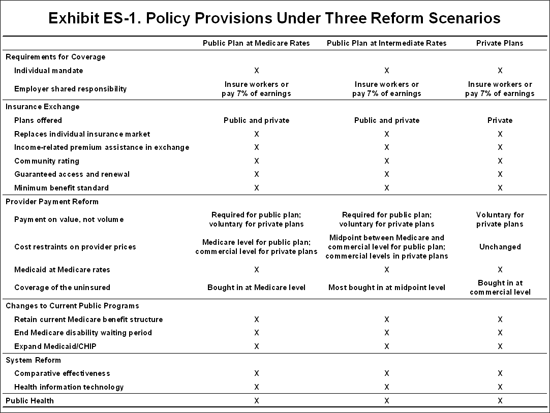
Although all three paths would achieve the goal of health insurance coverage for all, each would have different implications for major stakeholders and sources of coverage. Most important, these approaches would slow the growth of health spending to varying degrees and have different federal budget implications.
Analysis of these alternative paths yields the following results:
- Health system savings. All three paths would produce substantial health system savings over the 11-year period from 2010 through 2020, with cumulative savings of $3.0 trillion under the Public Plan with Medicare Payment Rates scenario, $2.0 trillion under the Public Plan with Intermediate Payment Rates scenario, and $1.2 trillion under the Private Plans scenario.
- Source of differences in savings. Differences in system savings under the three scenarios derive from insurance administrative savings realized by the offer of a public health insurance plan in competition with private plans; from the tighter payment rates used by the public plan; and from the application of payment innovations and system reforms to a greater share of the insured population under the two scenarios that feature a public plan.
- About $265 billion in insurance administrative savings are projected over 2010–2020 in the Public Plan with Medicare Payment Rates path compared with $223 billion in savings in the Public Plan with Intermediate Payment Rates path, while the Private Plans scenario would result in an increase in administrative costs of $32 billion.
- The great majority of system savings—ranging from $2.7 trillion to $1.2 trillion over 2010–2020 under the three scenarios—comes from greater efficiencies in care delivery and slower growth in health care spending. Revenues of providers continue to grow throughout the period, albeit at a slower rate than at present, and with differential effects across providers. In the absence of reform, cumulative national health expenditures will be $40 trillion over the 11 years.
- Bending the curve in health spending. The currently projected 6.5 percent annual rate of growth in national health expenditures over the 2010–2020 period would be reduced to 5.2 percent with the Public Plan with Medicare Payment Rates path, 5.6 percent with the Public Plan with Intermediate Payment Rates path, and 5.8 percent with the Private Plans path (Exhibit ES-2). The Public Plan with Medicare Payment Rates approach is the most aggressive in controlling costs but still slows health care cost growth less than the 1.5-percentage-point annual savings commitment recently offered by industry groups.
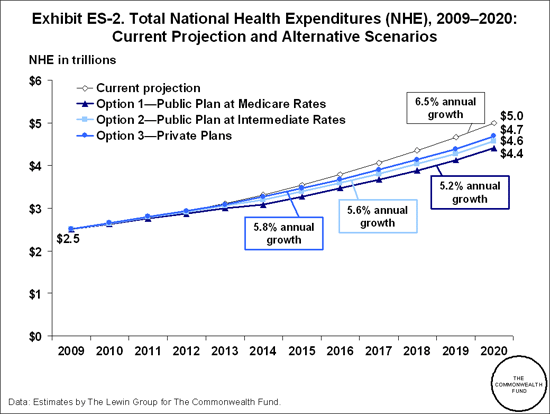
-
Share of economic resources. Although the percentage of GDP spent on health care would be lower in 2020 under each scenario compared with the currently projected 21.3 percent, health spending would in each case account for a higher share of the U.S. economy than the 17.6 percent expected in 2009—18.7 percent under the Public Plan with Medicare Payment Rates approach, 19.4 percent under the Public Plan with Intermediate Payment Rates approach, and 19.9 percent under
the Private Plans approach. - Expanded coverage. Under all three scenarios, the insurance expansion would bring about near-universal coverage. The number of uninsured would drop from an estimated 48 million in 2009 (16% of the population) to 4 million by 2012 (1% of the population), with that extent of coverage maintained through the end of the decade (Exhibit ES-3). Absent reform, the number of uninsured is projected to rise to at least 61 million by 2020.
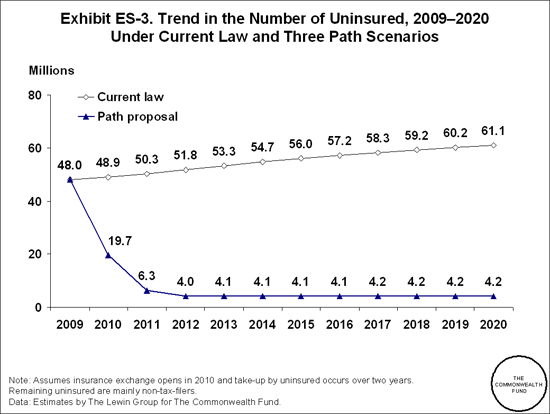
- Impact on premiums. Estimates indicate that premiums for the public plan choice in the Public Plan with Medicare Payment Rates path would initially be 25 percent below those currently available for a comparable benefit package in the private individual/small firm market and 16 percent lower under the Public Plan with Intermediate Payment Rates scenario (Exhibit ES-4). Private plan premiums would initially be 3 percent lower within the exchange as it facilitates the process of choosing plans and reduces administrative costs, especially for individuals and small businesses.
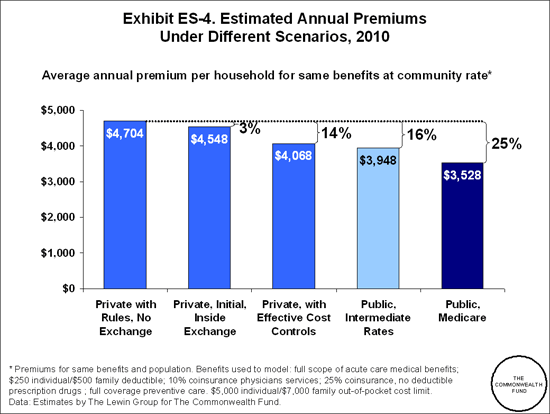
- Effective private-sector cost containment. Offering a public health insurance plan as an alternative choice should be a catalyst for private plans to innovate in the way they operate and pay for care. It would help them reduce their administrative costs and implement payment and system reforms that lead to more appropriate utilization, better care, and slower cost growth—and, in the process, contribute to reduced premiums. Community health plans partnering with integrated health care delivery systems in particular have considerable potential to achieve economies through redesign of care, control of chronic conditions, and prevention of avoidable hospitalizations. Private plans could also be given the authority to adopt public plan payment methods and rates. If private plans adopt effective cost-containment measures sufficient to slow a rise in their premiums relative to trends in public plan premiums, over a three-to-five-year period public plan premiums and private plan premiums within the exchange would be roughly comparable.
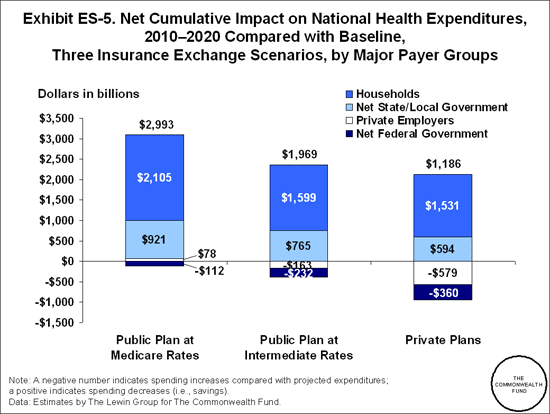
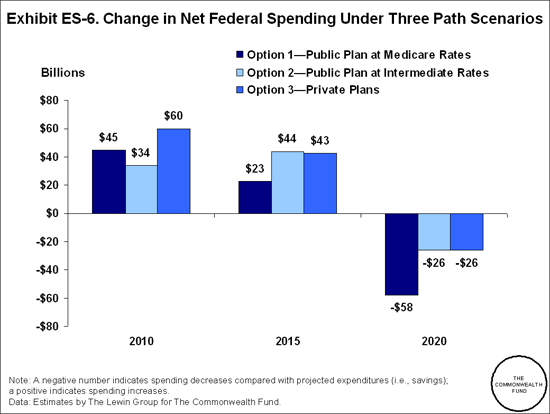
- Impact on federal budget. Over the 2010–2020 period, the cumulative net increase in federal budget outlays is estimated to be $112 billion under the Public Plan with Medicare Payment Rates scenario, $232 billion under the Public Plan with Intermediate Payment Rates scenario, and $360 billion under the Private Plans scenario (Exhibit ES-5). The federal budget costs of covering the uninsured and providing premium assistance to low-to-moderate-income working families are lowest under a public plan paying at Medicare rates and highest under private plans paying commercial provider payment rates. Under each scenario, most federal budget costs are incurred in the first five years, as the uninsured are covered and premium assistance is provided to low-to-moderate-income individuals (Exhibit ES-6). Over the longer term, most of the federal budget offsetting savings comes from Medicare payment and system reforms, as well as from increased taxes on tobacco, alcohol, and sugared soft drinks.
- Impact on employer costs. In all three scenarios, employers are required to cover workers or contribute 7 percent of workers’ earnings up to $1.25 an hour to a health insurance fund. As a result, those employers who do not now cover their employees would bear added cost. However, employers who now cover their workers would benefit from insurance, payment, and system reforms that lower insurance premiums and slow future growth in health care costs. Employers would fare best when their employees have access to a public health insurance plan that provides value for the premium dollar. Over the 2010–2020 period, payment and system savings with the Public Plan with Medicare Payment Rates path would offset any additional costs that health reform might produce for employers and workers as slower premium growth would result in net cumulative employer savings of $78 billion—although the effects on different employers would vary (Exhibit ES-5). Employers would incur $163 billion in increased cost under the Public Plan with Intermediate Payment Rates path and $579 billion under the Private Plans path over the 2010–2020 period.
- Impact on households. In all three scenarios, the bulk of total savings over time would benefit individuals and families as a result of slower growth in premiums and out-of-pocket spending, the availability of federal premium assistance, and the expansion of public programs to make insurance affordable. These savings would accrue across all income groups. By 2020, annual savings per household would average $2,228 under the Public Plan with Medicare Payment Rates scenario, $1,634 under the Public Plan with Intermediate Payment Rates scenario, and $1,576 under the Private Plans scenario. Total savings to households over the period from 2010 through 2020 under the three scenarios are estimated to be $2.1 trillion, $1.6 trillion, and $1.5 trillion, respectively (Exhibit ES-5).
In short, the presence of a public plan and the payment policies that it encompasses account for most of the total health system savings and federal budget cost differences among the alternative scenarios. Differing results reflect the relative aggressiveness and effectiveness of various cost-containment strategies and the creation of a new dynamic for transforming both health insurance and the provision of health care. The choice of a public plan provides a less-expensive base for expanding coverage than private plans, because a public plan would, at least initially, be paying at lower rates than private plans currently do (but at higher rates than most providers now receive for uninsured and Medicaid patients). Adoption of a public plan would also enable more rapid spread of payment reforms, since more people would be covered under plans that adopt those reforms. The public plan also achieves economies through lower insurance administrative costs. Although the outcome is difficult to predict, private plans, too, could be expected to respond to the new competitive dynamic, by partnering with integrated delivery systems to provide incentives and tools for more effective care, as well as to eliminate ineffective, avoidable, or duplicative care and achieve economies in insurance administration.
Although spending growth would slow, most providers would experience rising revenues and opportunities for shared savings, as preventable hospitalizations and greater efficiency in delivery of care are realized. Coverage of the uninsured and improved benefits for them would reduce bad debts and infuse new revenues into the health system in the early years, benefitting in particular the safety-net providers that now offer charity care to those who cannot pay.
At this critical juncture, the national reform debate should stay focused on the key coverage, payment, and system reforms that are necessary to put the nation on a path to high performance in health care. Recently, debate has centered on which direction the nation should take to move forward. However coverage is provided, reforms should ensure that everyone has the benefit of insurance plans that serve as agents for the public by pooling risk, paying for effective care, and requiring accountability for outcomes. The key issues should be how best to provide access to high-quality, affordable care for all, now and into the future. That is the goal of comprehensive health reform, and we should be careful not to lose sight of it.
All three paths described here, combined with an integrated set of payment and system reforms, would represent major steps toward the goal of covering the uninsured. But with the nation’s economic and fiscal future at risk, health reform must pay particular attention to effective strategies for altering the future course of spending for health care and increasing value obtained for the resources devoted to the health system.


